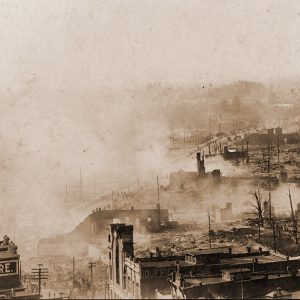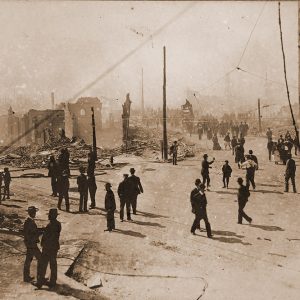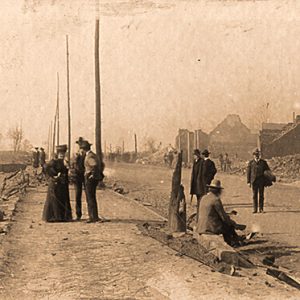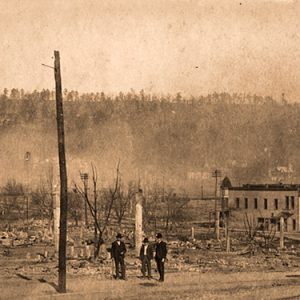calsfoundation@cals.org
Hot Springs Fire of 1905
The Hot Springs Fire of 1905 was one of the most destructive in Arkansas history. It destroyed nearly 400 buildings and caused $2 million in damage. The horrific blaze forever changed the unique architecture of Hot Springs (Garland County).
Hot Springs quickly rebuilt after the Civil War years of 1861–1865. The pre-war population of 201 had exploded to 9,973 residents by 1900. By 1904, it was the region’s most important tourist destination. Of the 120,000 people who visited at least one of America’s national parks in 1904, roughly eighty-four percent visited Hot Springs National Park. Unknown numbers of additional travelers visited the town but not the park. Most of the visitors came to bathe in the waters (thought to have healing properties) that gave the town its name, but many also enjoyed the town’s gambling and prostitution, despite their illegality. In contrast to the poverty that dominated much of Arkansas at the time, Hot Springs boasted elegant hotels, electric lights, and some of the finest medical facilities in the nation.
At approximately 3:00 a.m. on February 25, 1905, a fire broke out at the Grand Central Hotel on the south side of town at the intersection of Chapel and Crown streets, a block from Central Avenue. The cause of the fire was never determined. Most of the hotel guests had been asleep and escaped due to the quick action of the hotel’s night watchman and night clerk.
Firefighters sprang into action against the rapidly growing conflagration, but strong winds spread the flames to nearby buildings along Central Avenue. Terrified of burning alive, men and women leapt from the upper stories of hotels and homes. Residents poured into the streets to escape the fire or to search for loved ones among the carnage. Some people left the city entirely, scrambling over the rocky trails of West Mountain to get as far from the flames as possible.
At about 5:00 a.m., just when it appeared that the firefighters were starting to succeed, the town’s water pressure gave out. Firefighters organized civilians milling about in their pajamas into bucket brigades to fight the blaze. The combined efforts of numerous firefighters and civilians finally stopped the spread of the flames just before they penetrated the central business district.
By about 9:30 a.m., the fire had been extinguished. As many as twenty-five people were dead, and thousands were left without homes or jobs. Over a wide swath of more than 100 acres, up to 400 structures lay ruined, including iconic landmarks such as the famed Grand Central Hotel, the opulent Moody Hotel, the synagogue, and the Garland County Courthouse, which had held many of the region’s records.
Within hours, the people of Hot Springs began rebuilding their city. The new city was far grander than the city that disappeared in the inferno, as new building codes required the use of fire-resistant materials. Within a few years, most of the old, wooden structures that had dominated Hot Springs since its birth were gone, replaced with new buildings built or renovated to comply with the city’s post-1905 fire codes. These new buildings, made of stone and brick (such as those in the city’s celebrated historic district, Bathhouse Row), gave the town the unique look it retains in the twenty-first century.
For additional information:
Anthony, Isabel Burton. Garland County, Arkansas: Our History and Heritage. Hot Springs, AR: Garland County Historical Society, 2009.
Cockrell, Ron. The Hot Springs of Arkansas, America’s First National Park: The Administrative History of Hot Springs National Park. Washington DC: U.S. Department of the Interior, National Service, 2014.
Hanley, Ray. A Place Apart: A Pictorial History of Hot Springs, Arkansas. Fayetteville: University of Arkansas Press, 2011.
Paige, John C., and Laura E. Soullie`re. Out of the Vapors: A Social and Architectural History of Bathhouse Row: Hot Springs National Park, Arkansas. Washington DC: U.S. Department of the Interior, National Service, 1988.
Christopher Thrasher
National Park College
 Early Twentieth Century, 1901 through 1940
Early Twentieth Century, 1901 through 1940 Hot Springs Fire of 1905
Hot Springs Fire of 1905  Hot Springs Fire of 1905
Hot Springs Fire of 1905  Hot Springs Fire of 1905
Hot Springs Fire of 1905  Hot Springs Fire of 1905
Hot Springs Fire of 1905 




Comments
No comments on this entry yet.